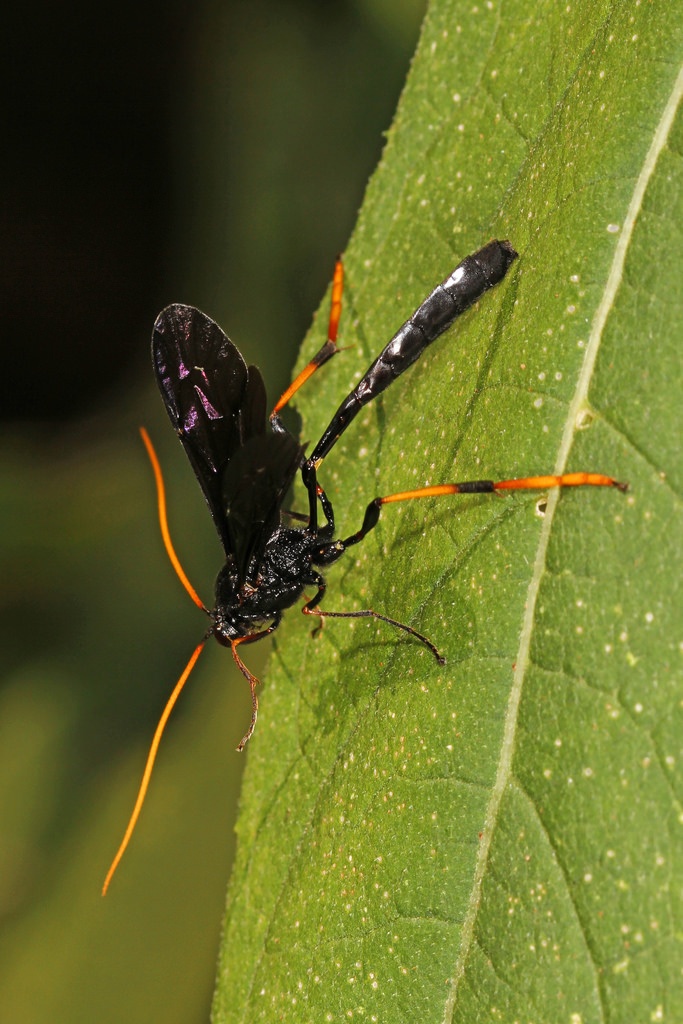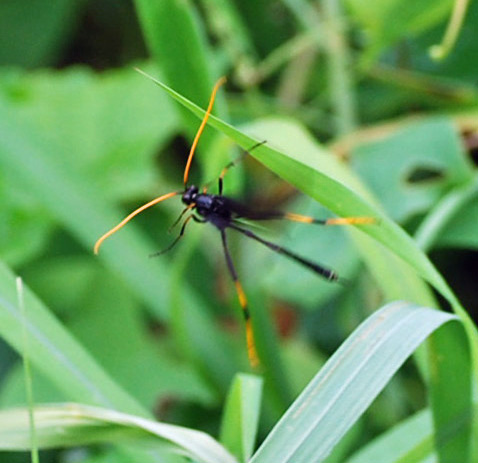Map Snapshot



2 Records
Seasonality Snapshot
Source: Wikipedia
| Therion morio | |
|---|---|

| |
| Scientific classification | |
| Domain: | Eukaryota |
| Kingdom: | Animalia |
| Phylum: | Arthropoda |
| Class: | Insecta |
| Order: | Hymenoptera |
| Family: | Ichneumonidae |
| Genus: | Therion |
| Species: | T. morio
|
| Binomial name | |
| Therion morio (Fabricius, 1781)
| |
| Synonyms | |
|
Exochilum Mundum (Say) | |
Therion morio is a species of parasitic ichneumon wasp in the family Ichneumonidae.[1][2][3][4][5] It is a parasite of the webworm caterpillar in North America.[6]
Reproduction
[edit]T. morio adults lay their eggs inside webworm caterpillars by piercing them with their ovipositor.[6] Like H. fulvipes, their eggs consist of an equatorial disc and a caudal stalk, making them look a bit like the cartoon oil lamp from Aladdin.[7] It's thought that the shape is adapted to attach the egg to the inside of the caterpillar's integument.[6] The egg partially hatches, and the next stage is termed a "feeding embryo", as this first stage larvae feeds through the inner membrane of the egg which still contains it. The second stage larva emerges from this inner membrane and continues to feed on the caterpillar. The head capsule of the second stage larva is much less chitinised than the first. The third stage larva is similar in appearance to the second stage larvae; Tothill describes it as a "dirty-looking, whitish grub." However, the third stage has spiracles.[6]
References
[edit]- ^ "Therion morio species details". Catalogue of Life. Retrieved 2018-04-11.
- ^ "Therion morio". GBIF. Retrieved 2018-04-11.
- ^ "Therion morio Species Information". BugGuide.net. Retrieved 2018-04-11.
- ^ "Therion morio Overview". Encyclopedia of Life. Retrieved 2018-04-11.
- ^ Carlson, Robert W. "Superfamily Ichneumonoidea, Discover Life". Retrieved 2018-04-11.
- ^ a b c d Tothill, John D. (1922). The natural control of the fall webworm (Hyphantria cunea Drury) in Canada : together with an account of its several parasites. Ottawa: F.A. Acland, King's Printer. pp. 88–102. doi:10.5962/bhl.title.63051.
- ^ Gauld, I. D. (1976). "THE CLASSIFICATION OF THE ANOMALONINAE HYMENOPTERA ICHNEUMONIDAE". Bulletin of the British Museum (Natural History) Entomology. 33: 1–135.
Further reading
[edit]- Arnett, Ross H. Jr. (2000). American Insects: A Handbook of the Insects of America North of Mexico (2nd ed.). CRC Press. ISBN 0-8493-0212-9.
- Krombein, Karl V.; Hurd Jr., Paul D. Jr.; Smith, David R.; Burks, B.D., eds. (1979). "Catalog of Hymenoptera in America North of Mexico". Smithsonian Institution Press. Retrieved 2018-04-11.
External links
[edit] Media related to Therion morio at Wikimedia Commons
Media related to Therion morio at Wikimedia Commons

